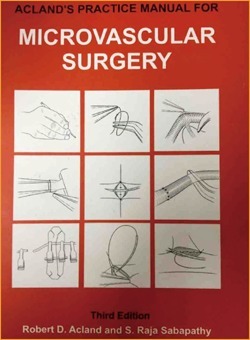Book Review: Acland's Practice Manual for Microvascular Surgery
Article information
Microsurgery had its origins in the early 20th century, but its development was nonexistent until the 1950s, when the basic foundations of microsurgical principles began to be developed in various surgical disciplines. The field of plastic and reconstructive surgery is credited for the development of vessel anastomosis and consequently anatomic free flap designs.
To his credit, I humbly point out the small but significant work of Dr. Robert Acland on the initial development of microsurgical instruments as well as the 10-0 nylon sutures we still use today. It was in those early days of microsurgical history that Dr. Acland wrote the first draft of a manuscript for a book on microsurgical techniques as well as the vessel clamp named after him.
Dr. Acland graduated from London Hospital Medical College in 1964 and trained at Princess Margaret Hospital and Canniesburn Hospital under Ian McGregor. In 1976, he was invited to the University of Louisville as the director of the microsurgical teaching laboratory (Kentucky, USA). It was during this tenure that Dr. Acland had published the first edition of what is now known as the "Red Book".
The current edition was revised in 2008 by a joint effort between the original author and Dr. Raja Sabapathy (Ganga Hospital) and is the sine-qua-non for any trainee in microsurgical techniques.
Its diminutive size (120 pages) may betray the practical nature of the Red Book. It is simple, clear, and to the point. Opening with a basic overview of microsurgical techniques, the discussion shifts to the fundamentals of surgical microscopes and their use. Any training microsurgeon would do well to heed the book's advice on evaluating and using microsurgical instruments properly. Finally, the book ends with detailed preparation for using animal models and the relevant anatomy.
For microsurgical trainees, the Red Book has no peer. It is the book that, for the young microsurgeon, has all the necessary information without superfluousness or pretention.

For seasoned microsurgeons, the book is a good refresher from time to time. More so, it provides a good perspective on challenges which Dr. Acland faced as a pioneer in the field of microsurgical techniques.
Notes
No potential conflict of interest relevant to this article was reported.